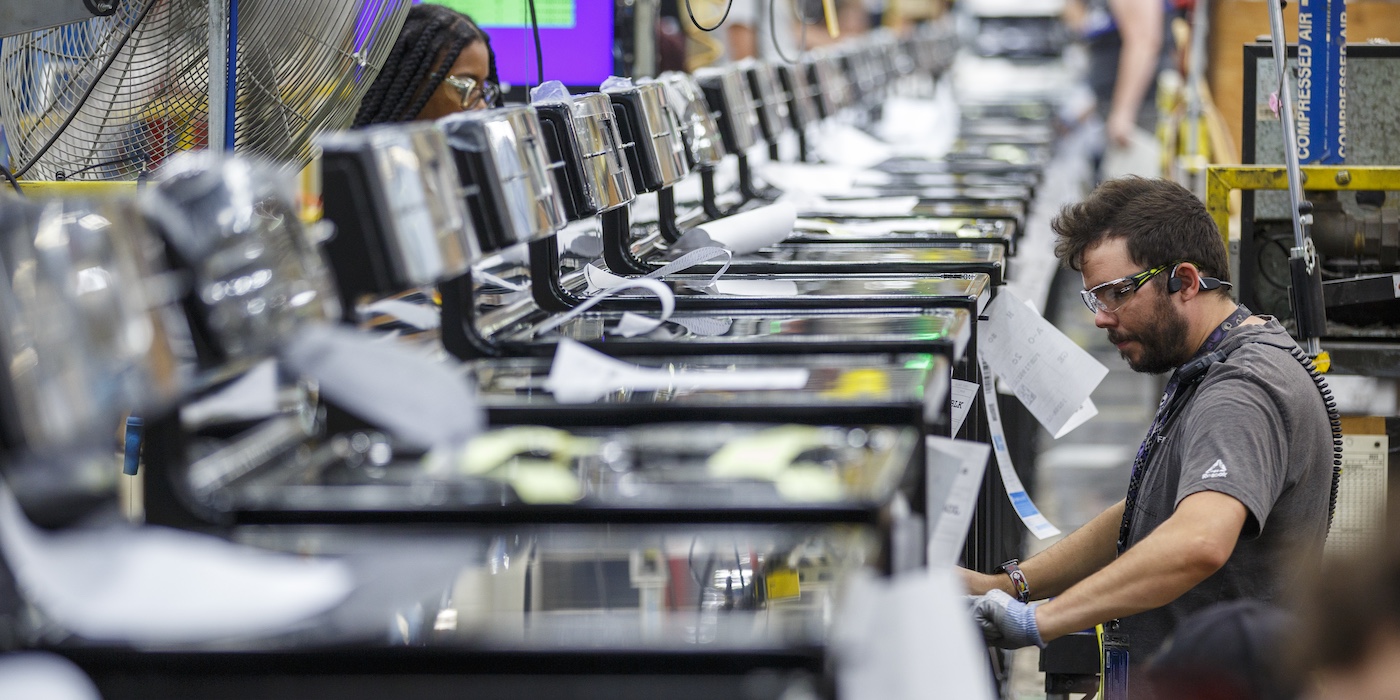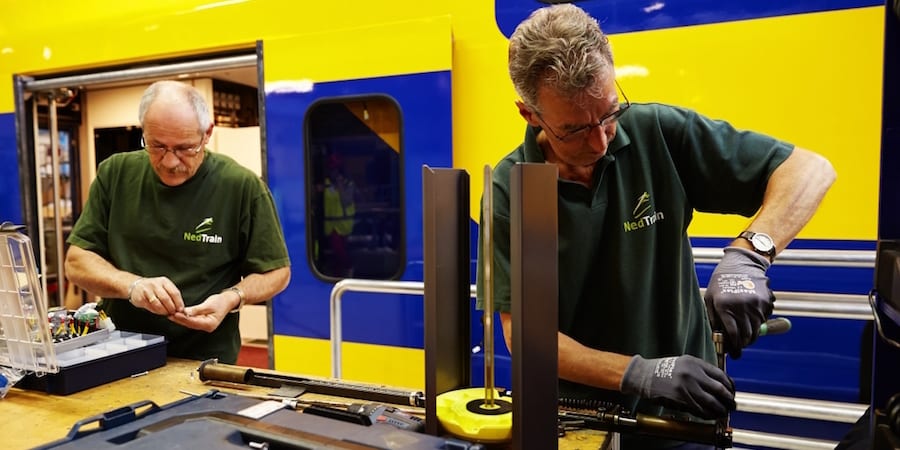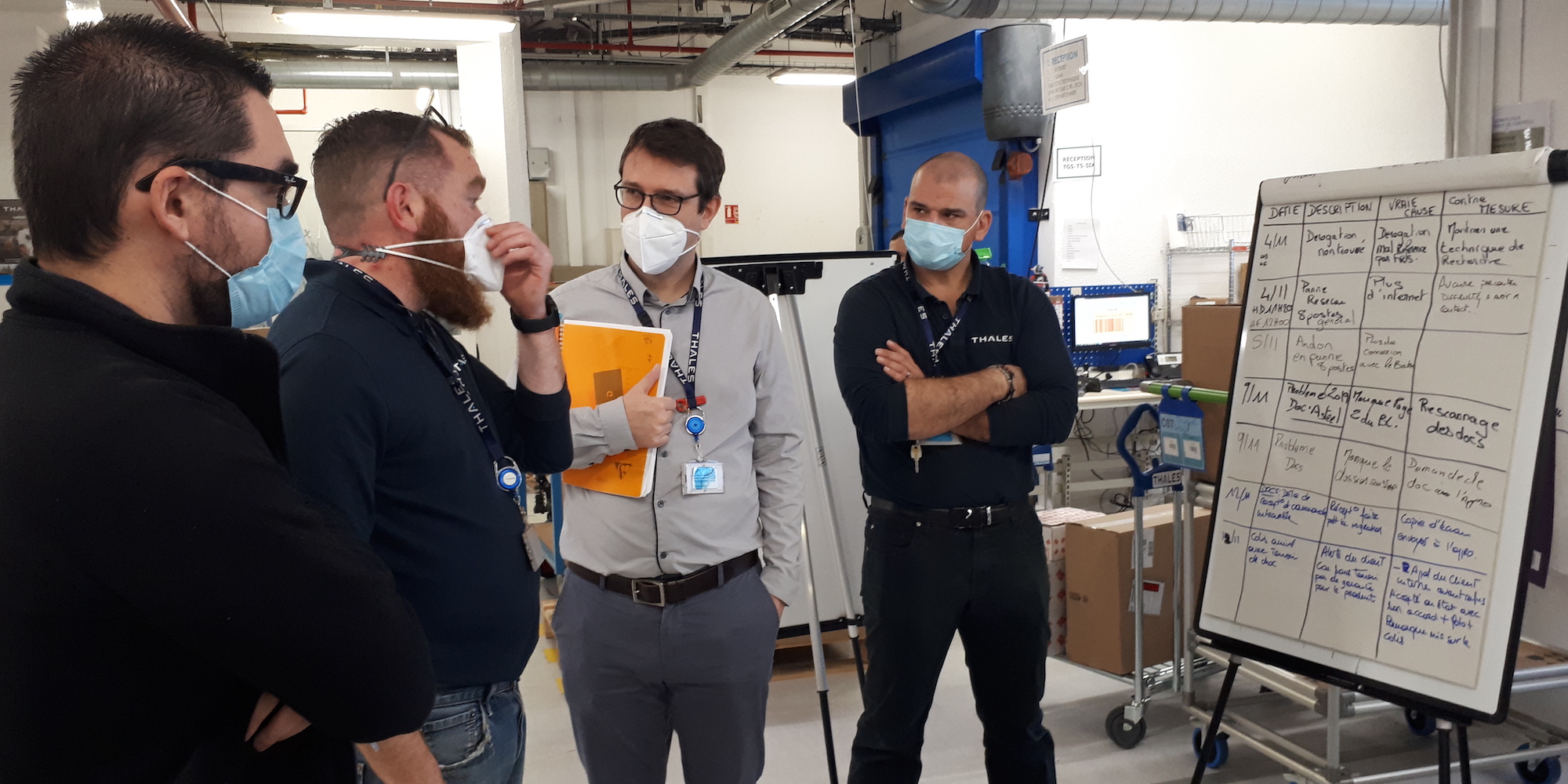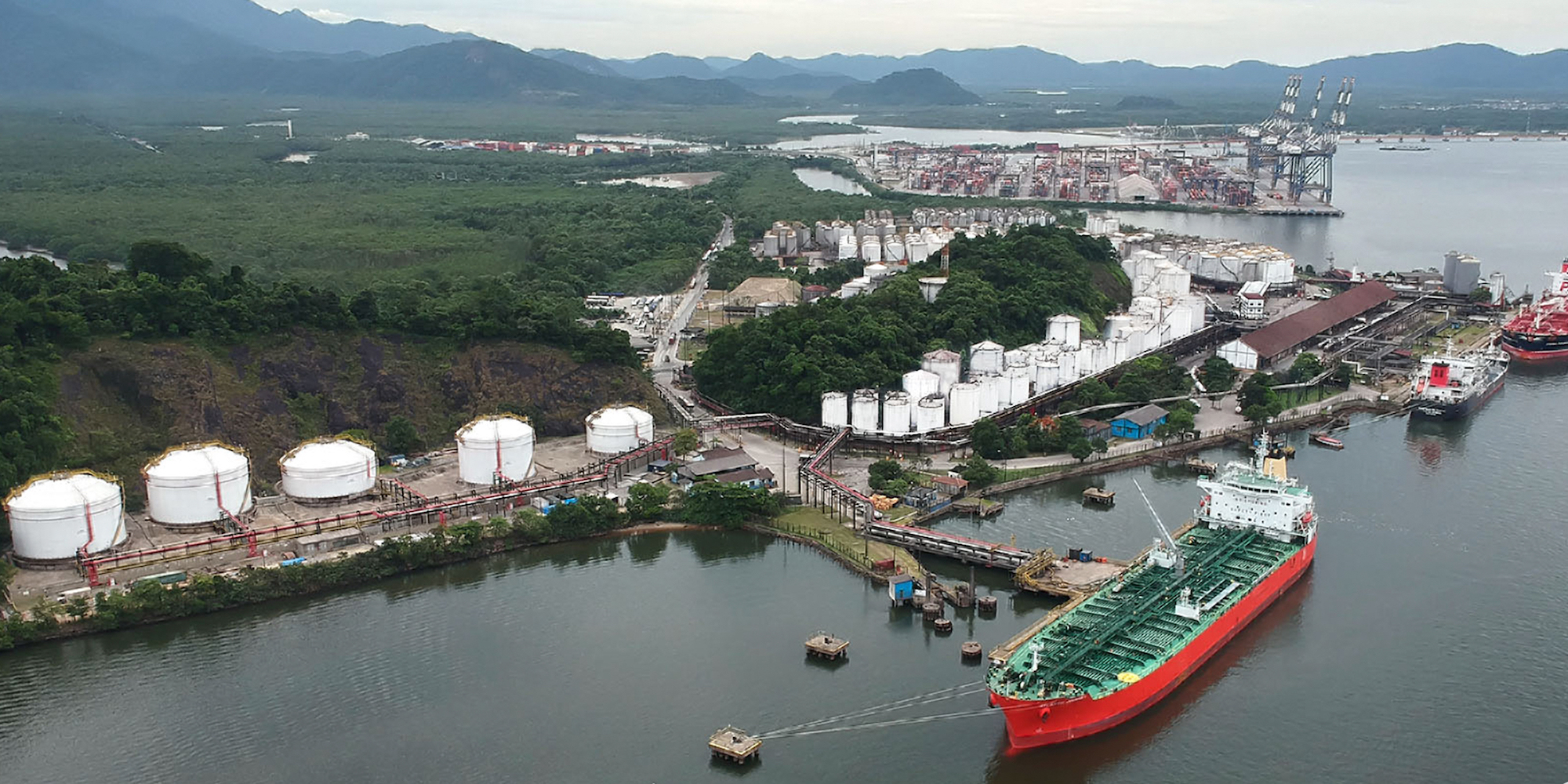
Transforming logistics: the lean journey at GE Appliances
INTERVIEW – Learn how Lean Thinking helped GE Appliances improve performance, develop people, and build a resilient, customer-focused, and learning-driven organization.
Interviewee: Marcia Brey, VP of Logistics, GE Appliances, a Haier company
Roberto Priolo: Can you give some background on GE Appliances’ lean journey and tell us about your role in it?
Marcia Brey: Our lean journey at GE Appliances started over two decades ago, when GE Corporate asked every division to establish a model line or site. We defined ours down at our subsidiary Roper, which still runs the Georgia manufacturing site that makes our cooking products.
The facility became our hub for learning kaizen and problem solving. As I took my first steps in the lean world, my first thought was that Lean sounded a lot like Six Sigma, but with a strong involvement of the people doing the work. GE was really strong on Six Sigma, but I always felt like the methodology’s focus on data (and, therefore, the “past”) often made it hard to understand what the real problem was. Lean, however, happens in real time and allows everyone to get involved – no matter their certifications or qualifications. I was immediately drawn to it and asked my manager to be put on a Kaizen team.
He agreed and, soon after that, I was at the Roper factory working on an improvement at the beginning of the distribution process. I loved my first Kaizen and knew at once that I wanted to learn more about Lean Thinking. My personal journey coincided with the company’s, which would soon embrace Lean and commit to incorporating it in its management system and daily practices. Standards and andon cords began to appear all around our plants, and our people started talking about flow and engaging in problem solving. Along the way, the company culture began to change, too, to the point that people working at GE Appliances today would struggle to recognize the organization as it was a couple decades ago. For those who have been with the company for a long time (in my case, 32 years), the difference with the “old way” is stark: over the years, the organization’s main focus moved away from individuals making their production numbers to teams solving problems together. That transition went hand in hand with a shift in leadership behaviors.
RP: Can you tell me more about the role of senior leadership in this transformation and how it’s changed over time?
MB: I need to start by saying that if you are not connected to your customer, nothing else matters. We realize how important it is to always know what they are thinking, what their needs are. That’s why we strive to co-create with them. As a leader, that means going to see, to identify any problems that might be occurring and provide support, but also to ensure we are still measuring ourselves against the right KPIs – the ones that matter to the customer.
I’ll go one step further: as VP of Logistics, my tendency is to go out when I hear something is happening, but I actually believe we need to start going out to see our customers when there is not a problem. They would love to talk to us not about issues they are experiencing, but about the opportunities they see. It’s not always about problems; it’s also about innovation, and it’s our role as leaders to always think of new and better ways to help our customers be successful.
Then there’s our employees. We want all of them to think like entrepreneurs, to take the initiative to always makes things better. And that means that we, as leaders, need to ensure they are engaged and that they understand there is a purpose to everything they do, that they all contribute to the success of the business. Our responsibility is not to tell our employees how great it is to work at GE Appliances; it is to understand each individual’s needs and aspirations, and do our best to meet them. I might not be able to forge the perfect one-on-one relationship with all of my 300+ employees, but I can set that example with my team. It took me a while to realize I wasn’t supposed to make all the hard decisions on my own, instead allowing my people to provide input to help me make better decisions. I’m blessed to work in an environment that allows for that kind of cooperation. To me, this is a reminder of how important it is to develop people, by learning to be a good listener and to ask the right questions.
This applies to our CEO, as well. Kevin Nolan has fundamentally transformed the role of the CEO at GE Appliances. He sets a high-level vision and encourages his leadership team to think of the best way to turn that vision into a reality. I think that’s because he recognizes nobody has all the answers – not even the CEO. For us, it’s all about working together toward a common purpose.

RP: The approach that clearly defines everyone’s role and contribution to the company strategy is hoshin kanri. What’s your experience with it at GE Appliances?
MB: We naturally gravitated towards hoshin, precisely because it allows us to translate our vision into actionable items that every department, team or individual can focus on. What I love most about it is that it takes so much ambiguity out of the day-to-day or even month-to-month decisions that need to be made.
Let me give you an example of how we organize our management system around hoshin. Each team runs a monthly hoshin KPI check to assess how projects are going and highlight any relevant learning. On top of that, we have a daily management system, with meetings that give our team members the pulse of the situation at all times. If a problem or a crisis occurs, most of the time we don’t need to call an emergency meeting; we just meet within the scope of the daily management system. This proves that the system allows people to remain calm and in control, no matter what challenge might be thrown at them (most recently, tariffs), and to stick to the hoshin until it is updated.
When a change of direction is required, hoshin allows us to perform it swiftly and with minimal disruption. That’s because it enables communication across teams and gives everyone a voice – and, therefore, a stake – in the process.
RP: Where is the Logistics Department in its own lean journey?
MB: Lean Thinking is an ongoing journey, and just like any organization, the Logistics Department continues to evolve and refine its approach. One of our strategic long-term goals is ensuring that we represent the voice of the customer. To support this, we have structured our supply chain into two main pieces: one is sourcing and manufacturing; the other is logistics. My team is responsible for finished goods distribution and fulfillment, including forecasting demand, informing factories of production needs based on sales forecasts, and overseeing customer service to ensure order accuracy and fulfillment. We also manage final-mile delivery, including full installations for both residential and new construction, as well as reverse logistics.
A key turning point in our lean journey came when we reorganized our reporting structure. Two years ago, we shifted to report directly to the Chief Commercial Officer, aligning us closely with sales and marketing. Initially, I didn’t understand that move. However, I soon realized the benefit: our team interacts with customers daily, making us the ideal link between supply chain operations and customer experience. Being embedded with sales allows us to hear customer pain points firsthand and translate them effectively into business solutions.
This structure has also improved our problem-solving approach. The sales team, while experts in customer interactions, may not always fully understand our lean processes. They might hear a customer issue but not know how to translate it into actionable feedback – or they might assume a problem simply can’t be fixed. By working closely together, we make sure we go see the issue firsthand, involve the right teams, and find practical solutions.
To sustain our lean journey, we focus on key methodologies, like A3 Thinking (to ensure problems are defined clearly) and standardized work (without it, improvements can’t be measured or sustained). We also have an Obeya room, which we use for ongoing strategy alignment and problem solving.
We are also intentional about developing talent. If you're on my team, you’ll receive specific lean training with the expectation that after 18 months to two years, you'll move into another role. This keeps everyone’s perspective fresh and strengthens our overall organization.
RP: What is the department’s hoshin currently focusing on?
MB: In our hoshin, there are nine key objectives at the moment. Three of them tend to remain constant every year:
- Cost reduction and waste elimination – We are always focused on improving productivity, removing waste, and creating better flow for our finished goods.
- Service excellence – Our priority is serving customers effectively. In fact, we had to adjust this metric after realizing that what we initially measured wasn’t fully aligned with what our customers actually needed.
- Damage reduction – While damage could be considered both a cost and service metric, it’s such a critical pain point for customers that it deserves its own focus. Our damage levels are already strong, but we always strive for perfection because it impacts every aspect of the customer experience.
Beyond these core three, the other six objectives are aligned with the broader needs of the company, including things like product team priorities, financial goals, reputation and brand image, and our CEO’s vision.
Notably, we don’t include factors we can’t control, like tariffs. That doesn’t mean they don’t impact us – it just means that while we adapt to them, they aren’t part of our strategic foundation.

RP: How do you ensure alignment between logistics and product teams within the Hoshin framework?
MB: Our product teams are closest to the customer, which is why my role as a platform (function) leader is designed to sit just below them in the Hoshin framework. My primary job is not just to lead Logistics, but also to support our product teams, ensuring they have what they need to move quickly and efficiently.
To do this, I stay closely connected with them, constantly asking what their biggest pain points are, what concerns or opportunities they see, and how I can help them move faster.
This direct input shapes my Hoshin plan for the year and ensures Logistics isn't operating in a vacuum. Instead, our work aligns with the entire organization’s goals, all the way up to our CEO. My job is to provide options to product teams, not just to say yes or no. Sometimes there’s a healthy tension – if a product VP asks for a shipping change, for example, I might push back and ask if they have considered the cost impact. This isn't resistance; it's the catch-ball process in action, where we work together to find the best solution.
This collaboration is built into our rhythm, rather than being something separate that requires special meetings. Every month, whether there’s a crisis or not, I meet with our product line leaders to share updates on Logistics, hear their latest challenges and risks, and ensure we are aligned and ready to pivot if needed.
The power of this approach was especially clear during the laundry combo launch. The factory faced delays, but because our team understood how critical this launch was, we proactively problem-solved to keep things moving. When the product finally launched successfully, we all celebrated together. We know we are all part of the same team. That’s the true power of Lean Thinking and the Hoshin framework – everyone understands their role in the bigger picture, and that creates real engagement and impact.
RP: Speaking of innovation, GE Appliances seems to have a strong new product development process. But you also have experience designing processes, right? That’s the “P” in Lean Product and Process Development that many companies tend to forget about.
MB: Mapping a process starts with understanding what’s actually happening, not just what we think should be happening. It’s crucial to identify gaps and pain points before making changes. When we go through this exercise, we make it visual – using whiteboards, laying things out on the floor, and bringing in different perspectives. We then go see the process in action, validate our findings, and translate them into a clear, visual representation.
Once we have mapped the process, the question becomes whether we fix it or create something entirely new.
That’s where LPPD comes in. Last year, we faced a challenge with a specific builder customer segment – we weren’t delivering as expected, but didn’t understand why. So, we went out into the field. I personally visited 10 different locations, and we sent teams across the country. Transportation managers, process owners – everyone who touched the process went out to observe.
We reconvened in Dallas to share insights, focusing not just on what was wrong, but also on what the customer actually wanted. We quickly realized that simply fixing the process wouldn’t get us there. Instead, we needed a blank slate approach.
We brought in cross-functional teams – sales, legal, transportation, pricing, PMOs – and started from the end result, working backward to define what we wanted to achieve, how we planned to get there, and what steps would be required. We focused on developing standards to ensure consistency, specifying roles and responsibilities, and defining clear KPIs to measure success.
Once we had this framework, we didn’t jump straight into execution. Before automating anything, we manually simulated the process (that’s all you can do when you can’t test in real time) and ran small experiments.
This step-change approach made all the difference. We were able to reduce cycle time by 70%, improve efficiency by 20% by optimizing resources (we repurposed roles without any job losses), and created a new standard that the client loves.
Now, we’re continuously kaizening the process. It’s not perfect, but it’s iterative improvement. We’ll refine it until it’s time for the next vision.
RP: What did that process development experience teach you?
MB: Two major takeaways stood out from this experience. First of all, the importance of clear roles and cross-functional understanding. In a non-manufacturing environment, people often don’t fully understand each other’s roles. When we brought together legal, sales, transportation, and pricing, we quickly realized there were knowledge gaps – for example, our legal team didn’t fully understand pricing, and sales didn’t grasp the complexities of transportation. Having a PMO (Program Management Office) resource was critical. In our technology and NPI (New Product Introduction) processes, PMOs are heavily involved, but we hadn’t embedded one in this kind of project before. So, I decided to pull a dedicated PMO resource into this initiative, and she played a key role in structuring the schedule, vision, and overall coordination.
This reinforced a fundamental truth: cross-functional collaboration is complex, and having a dedicated connector – someone with system thinking who can oversee the big picture – is extremely helpful.
The second takeaway was the power of change management. When implementing large-scale process changes, it’s not enough to assume that individuals will naturally manage change. This was a big system shift, so we dedicated a full-time change management resource to focus solely on keeping stakeholders aligned, identifying and addressing internal resistance, and ensuring the customer perspective remained central to the effort.
I hadn’t done that before. We typically expect individual leaders to manage change within their own teams. But for major transformations, having someone fully dedicated to tracking alignment, engagement, and feedback was a game-changer.

RP: Speaking of learnings, what’s the most important lesson you have learned about lean over the course of your career at GE Appliances?
MB: One of the most important lessons I’ve learned about Lean is that the goal is learning and improving. Early in my career, I worked on a Six Sigma project, and I was completely committed to the idea of “doing it right the first time.” I had this mindset that we would put the perfect processes in place, achieve 3.4 defects per million, and eliminate errors completely. But over time, I realized that’s not necessarily how it works.
Lean is about aspiring for perfection, sure, but it’s also about getting better every time. The real value comes from testing, trying, learning, and iterating. If I could go back and tell my younger self one thing, it would be to not be so arrogant to think that I – or anyone – would get it right first time.
Another major lesson, which I mentioned earlier, was understanding that being an effective leader isn’t about having all the right answers, but about asking the right questions with humility and curiosity.
When I became a plant manager, for example, I had very little factory experience. But I had great mentors and a CEO who believed in me. My lean coach, Rich Calvary, urged me to go see and so I did. But I also went and did. I worked on the line, side by side with the team, trying to assemble refrigerators. I put on work gloves. I struggled, pulling my andon cord many times, and the people on the line saw me struggle. That created a genuine connection.
The experience taught me what good and bad standard work looks like, what good and bad training looks like, and how it feels to be in the process. It shaped how I lead and made me a better listener and a better questioner.
At the end of the day, Lean isn’t just about process improvement; it’s about people. We’re here for a short time, and the more we connect, learn, and experience each other’s worlds, the better we make things. My advice is to go see, but, more importantly, to go do.
THE INTERVIEWEE

Read more


INTERVIEW - Thanks to strong leadership support and an effective system to partner with private sector firms, Washington State is proving how successful lean production principles can be in a government setting.


FEATURE - In the second article in his series, the author provides helpful tips for those interesting in bringing some Lean Thinking to their parenting, focusing on the first five years of a child's life.


FEATURE – Faced with long lead-times to hire new people and with tens of millions paid in sick leave every year, the HR department of Dutch railway operator NS has turned to lean thinking to set them on the right track for the future.


CASE STUDY – This hotel in Spain has been able to leverage Lean Thinking in its restaurant to successfully adapt to the new Covid-19 regulations enforced in the country, becoming more efficient along the way.
Read more


FEATURE – Focused experimentation and kaizen can lead to impressive results in as little as one day, as the story of this Hungarian company shows.


CASE STUDY – The implementation of lean in the internal logistics of a pharmaceutical company in Brazil proved key to increasing productivity and quality in the organization.


NOTES FROM THE GEMBA – Thanks to the effective application of Just-in-time and Jidoka, Thales LAS has managed to turn around its logistics department. Catherine Chabiron reports.


CASE STUDY – Logistics can be the key to achieving success and creating a competitive advantage in a company. This case study tells the story of a port terminal in Brazil that has used lean to achieve significant gains in managing its road flow.

